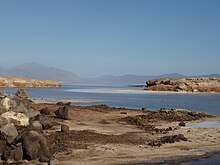Geology of Djibouti
Djibouti's geology consists largely of volcanic rocks from the Miocene and Holocene . There are newer alluvial deposits with coral on the coast as well as Cenozoic sediments . Amba Aradam sandstones from the Jurassic period are located in the southeast of the country.
Geological overview
The land was formed by the collision of general tectonic currents from the East African Rift . The crack created a fragmented relief , which consisted of high blocks and sinking zones that gave rise to geological features such as Lake Assal .
tectonics
The Gulf of Aden on the Red Sea split during the Pliocene and the Early Pleistocene . During these epochs the Danakil Horst experienced an increase in its southern area. Analyzes of the plate tectonics in the Afar triangle show annual elongation rates between one and three mm.
Geohisk
Volcanic eruptions and earthquakes occur in the Afar Triangle of the Great Rift Valley .
Economic impact
Although Djibouti produces minerals, it is a significant part of its economy. Salt is extracted in evaporation basins at Lake Assal and contributes to the country becoming the tenth largest salt producer in Africa . Limestone and calcined lime are also currently mined in Djibouti. Likewise, marble , granite , gypsum , diatomaceous earth and perlite are mined.
In 2016, preliminary work will be carried out on the production of crude oil .
In addition to mining, the possibility of using geothermal energy was explored in 2016 .
education
Djibouti's new university offers courses in geology and earth sciences.
Individual evidence
- ^ Thomas Schlueter: Geological Atlas of Africa: With Notes on Stratigraphy, Tectonics, Economic Geology, Geohazards, Geosites and Geoscientific Education of Each Country . Springer Science & Business Media, 2008, ISBN 978-3-540-76373-4 ( google.de [accessed June 15, 2019]).
- ↑ a b c d e f M. TC Media: EI Sourcebook | Maps and Links. Retrieved June 15, 2019 .
- ^ Thomas Schlueter: Geological Atlas of Africa: With Notes on Stratigraphy, Tectonics, Economic Geology, Geohazards, Geosites and Geoscientific Education of Each Country . Springer Science & Business Media, 2008, ISBN 978-3-540-76373-4 ( google.de [accessed June 15, 2019]).
- ↑ MTC Media: EI Sourcebook | Extractive Industries. Retrieved June 15, 2019 .
